Reproduction of clematis - how to carry out the procedure at home
Reproduction of clematis allows you to get new young specimens of these plants. The culture gained its popularity due to its low maintenance requirements and high decorative qualities, suitable for use in landscape design. Consider how to carry out the procedure at home.
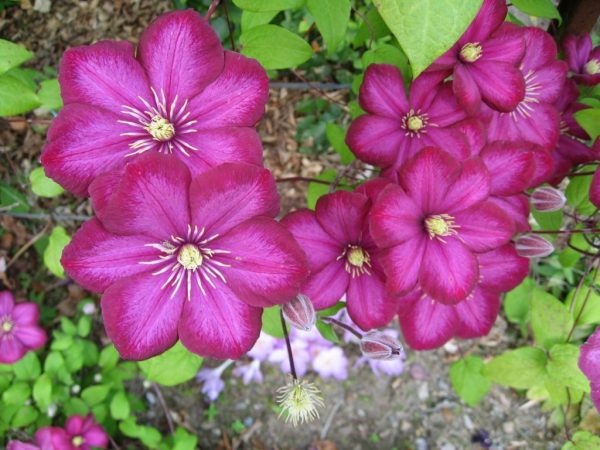
Pink clematis - garden decoration
Reproduction methods
Cuttings
Reproduction of clematis by cuttings is one of the easiest and most productive methods. As a mother bush, choose one that grows in one place for at least 3 years. In this case, it is allowed to cut off no more than ⅓ of the total volume of all vegetative processes.
Plants in the flowering stage cannot be propagated.
You can determine the readiness of the stem for rooting by slightly bending it - it should be elastic and not break.
Step-by-step instruction:
- In suitable lashes, the top is cut off so that 2 growth buds remain from the base on the bush. In this case, at the most distant process, at least one node must be preserved, which also consists of a pair of sheet plates. In the case of short internodes not exceeding 5 cm in length, it is allowed to increase the dimensions of the cutting by 2 times.
- The lower part is cut off at an acute angle (3 cm below the node), the apical part - horizontally, stepping back about 3 cm relative to the nodal point upwards.
- Planting containers are prepared (using wooden boxes, cut plastic bottles or disposable cups).
- A 15 cm layer of river sand and peat is poured into the container, 5 cm thick perlite is distributed on top.
- They moisturize the substrate well.
- The oblique cut of the cutting is treated with a rooting stimulator, dipped at an angle into the soil mixture. Tamp the ground near the base. When planting, groups of plants maintain a distance of 8-10 cm.
- Placed in a greenhouse with high humidity and a temperature of 25 degrees. After 5 weeks, the appearance of the first roots is observed.
Layers
Reproduction of clematis by layering is a reliable method. It does not allow too many branches to be rooted, but it does not require much labor. The requirements for the mother bush are identical to those for the method in which green cuttings are used: a minimum age of 3 years, a highly developed root system and a sufficient number of one-year shoots.
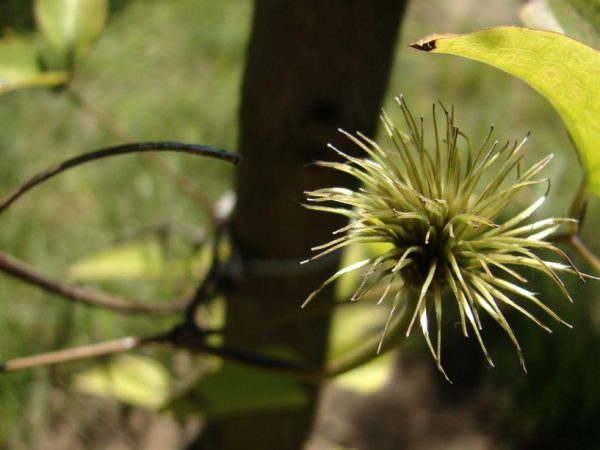
Reproduction of clematis at home
There are several options for obtaining layering.
- Upper. In the spring, the lower knot of the young sprout is bent to the surface and sprinkled with earth. At the end of the season, when the roots are formed, they are separated from the mother bush. This approach also helps to strengthen the root system of an adult plant.
- Horizontal. A nearby groove is prepared, into which the winding branch is completely driven in.With proper care, each node forms separate roots, thereby it is possible to get several seedlings from a single segment at once. Young clematis are planted in new places either at the end of the current season or next spring.
- Orlov's method. The principle of the method is similar to the horizontal one. The difference lies in the fact that it is necessary to cover the nodes with the substrate through one.
- Air. Another easy option for the culture to propagate. Assumes the use of moss instead of earth. During the procedure, using sharp garden tools, an incision is made on the shoot up to half its thickness. Then the wound is treated with a biostimulator of root formation, covered with wet sphagnum, covered with a film. Additionally, a support is installed. Cropped from the mother plant after roots begin to sprout through the plant material.
By dividing the bush
The division of the bush is technically difficult to implement and laborious. In addition, it requires some experience from the gardener, and is also recommended for use only if it is necessary to transplant adult specimens.
It is allowed to take plants that have reached a minimum age of 5-6 years.
During the procedure, the shrubs are dug out of the ground and the root system is gently washed. After the rhizome is divided into segments by means of a sharp disinfected secateurs.
In addition to the underground part, it is necessary to leave some healthy shoots. Places of cuts are additionally sprinkled with crushed activated carbon.
At the end, the plants are placed in the prepared holes a little deeper than before, and watered abundantly.
Reproduction in water
This method is all the same grafting, only instead of the soil mixture, water is used until the roots are formed. To be able to plant young growth in a flower bed in September, the seed is cut in July. Leaves leave only those that will be in a humid environment.
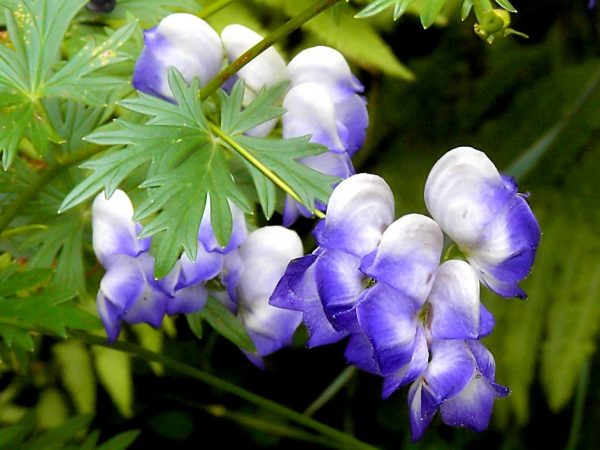
Clematis is a flower that grows in any conditions
Additionally, the timing of keeping the cuttings in liquid should be strictly observed; it is strictly forbidden to overexpose them. Otherwise, the risk of root tangling and drying out of the growth buds increases.
It is best to place the container with the scions in a shaded room or wrap it in foil. On average, the first roots are formed as early as 30-40 days, after which they can be planted in a greenhouse for further growing.
Hilling
It involves the installation of a box with only one side in the immediate vicinity of the crop. The optimal time for work is June.
Throughout the summer, soil is regularly poured into the container until it is completely filled. As a result, only a fragment of a branch with 2 internodes should remain open. Do not forget to water the soil abundantly in the process of such rooting.
By the onset of autumn, the apical part of the shoot is cut off, leaving about 20 cm from the entire length, spud around the perimeter and covered for the winter.
Seeds
The use of seeds is not suitable for growing varietal clematis, because as a result, almost all the characteristics of the mother bush are lost - from a large one, it may well become small-flowered. At the same time, there is a high productivity from the procedure in the case of planting smaller seeds up to 3 cm.
To speed up the germination of seedlings, it is recommended to subject the material to stratification. It is first soaked in water for several hours, then placed in a moist substrate and transferred to a refrigerator for up to 3 months.
In April, the seed of the flower is embedded in the soil. However, it should be borne in mind that young clematis are extremely sensitive to a pick.
Breeding features
In summer
The procedure is carried out during the growing season of the flower.
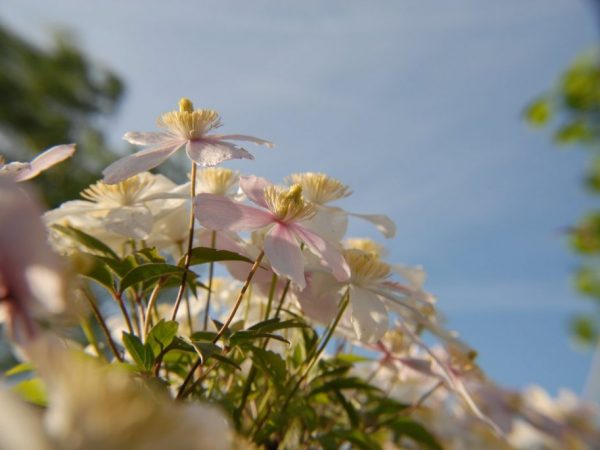
Clematis during the summer growing season
In regions with a warm climate, the material must be prepared in June, in the northern regions - a month later.In August, planting is also allowed, but in this case it lasts longer.
Also, professional gardeners recommend focusing on the budding stage, it is in this phase that it is better to prune green cuttings.
Further care:
- Moisture readings should be high enough.
- The container is placed in a place protected from direct sun. If this is not possible, the container is wrapped in thick paper or foil.
- Temperature - 22-25 ° C.
- Additionally, it is necessary to regularly ventilate the greenhouse and spray green cuttings from a fine spray.
In the spring
The most favorable time for pruning seed is May. At the same time, the readiness of the shoots is checked by their mechanical deformation - after bending, the branch should remain intact.
Important! It is recommended not to cut the cuttings with a sharp tool, but to carefully break them out.
In autumn
The breeding procedure for clematis begins in September.
Instead of green cuttings, preference is given to woody shoots, they are embedded at a slope into the substrate to a depth of 3 cm. The soil is thoroughly moistened, the container is placed in a cool place.
Use enameled or any shatterproof dish, which is transferred to the greenhouse in March, where the temperature is gradually increased. When the young growth reaches 10 cm, it is pinched.
In winter
It is important to control the growth of the plant, it is desirable that the buds do not have time to awaken before the onset of heat.
The subtleties of keeping cuttings in the cold season:
- if the sprouts take root in an unheated greenhouse, the young growth must be additionally covered with spruce branches;
- it is best to use non-woven agrofiber as a covering material, through which the shrub will be able to breathe;
- after the shoots have released the offspring, they are pinched when they reach a maximum of 12 centimeters in height.
Useful tips from experienced gardeners
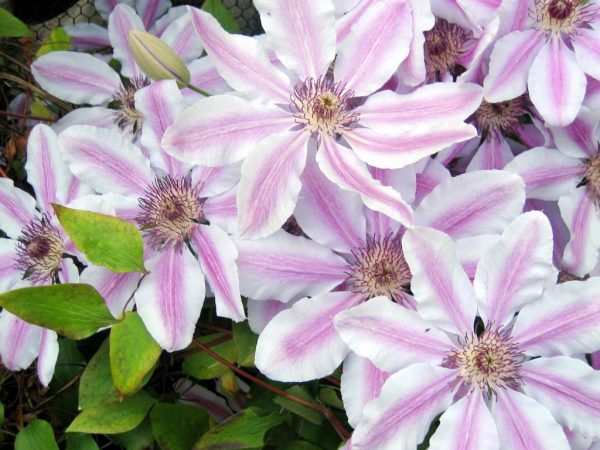
Even inexperienced gardeners grow soft pink clematis.
- It is better to use a sharp knife as an inventory, the pruner is able to deform the shoot.
- The cut is made at an angle of 45 degrees, thereby increasing the area for the formation of roots.
- Ideally clean bottles are taken for rooting in water, otherwise the risk of decay of the processes increases.
- For planting, a disinfected soil mixture is recommended, which can be disinfected by calcining in an oven or watering with a solution of potassium permanganate.
- Before being identified in open ground, the bushes are hardened, exposing them to fresh air for a short time.
- In the case of using seeds, they must be stratified.

